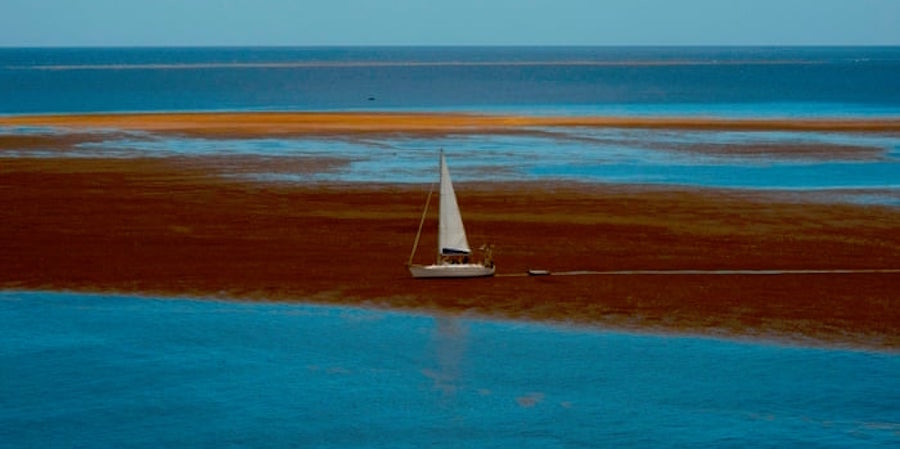It weighs 20m tonnes, stretches from West Africa to the Gulf of Mexico, and washes up on beaches creating a malodorous stench. Now scientists say a vast swathe of brown seaweed could be becoming an annual occurrence.
Researchers say the explosion in sargassum seaweed first materialised in 2011. But new research shows it has appeared almost every year since then, forming the largest bloom of macroalgae ever recorded. What’s more, the seaweed band – dubbed the Great Atlantic Sargassum Belt – seems to be getting bigger.
The scientists say the seaweed can be a boon for marine wildlife, providing habitat for creatures including fish and birds.
But it also brings problems. Thick mats can block sunlight, while if large mats die and sink it can prove deadly for marine life, including coral.
The seaweed has also proved devastating for humans. Increasingly huge quantities are washing up in tourist destinations, creating stinking masses that threaten the tourism industry and pose a threat to health. Last month, the Mexican state of Quintana Roo declared a state of emergency over sargassum.
“There are good implications and there are bad implications,” said Dr Chuanmin Hu, co-author of the study from the University of South Florida. “Many people in the Caribbean are literally crying because their economy has suffered so much.”
Writing in the journal Science, Hu and colleagues say sargassum is far from uncommon in the Atlantic: mats of the seaweed, which they say were first reported by Christopher Columbus, gave the Sargasso Sea region of the north Atlantic its name.
However, the phenomenon of such a vast quantity of the macroalgae appears to be a recent development, first showing up in satellite data in 2011. While the discovery was exciting, there was a hitch. “The satellite used to study the bloom stopped functioning in 2012,” said Hu.
Now, Hu and colleagues report the analysis of a 19-year record of another set of data from a satellite instrument that measures wavelengths of light reflected from the ocean surface. That, they say, allowed them to examine how the bloom has developed, and explore what the future holds.
The results show that between 2000 and 2010 there was little seaweed in the central Atlantic: most was found in the Gulf of Mexico and Sargasso Sea.
But in 2011 a large bloom arose and developed over subsequent years into a vast band – in 2018 this stretched for 5,500 miles (8,850km).
The researchers found the bloom peaks in the middle of the year, and say computer models suggest it appears to develop largely from small populations of the seaweed in the central Atlantic, with some contribution from West Africa. “They are always there, but once the ocean conditions are right they just develop into blooms and then large amounts of sargassum are transported to the Caribbean,” said Hu.
The trigger for the 2011 event seems to have been an alignment of circumstances, with conducive sea-surface temperatures and salinity combining with an increase in nutrients – in part from the upwards movement of cool, nutrient-rich water in the eastern Atlantic and an increase in discharge from the Amazon in the preceding years.
So far, 2019 also looks set for a huge bloom. “It’s another record year,” said Hu, adding that the frequent recurrence of the Great Atlantic Sargassum Belt raises the possibility that the phenomenon may be the new status quo. “We cannot predict individual years, but we can predict the next decade in general,” he said.
The prospect, the team says, could be strengthened by the finding that increasing levels of nutrients are being flushed into the ocean via the Amazon in the spring and summer each year, as a result of human activities including deforestation and fertiliser use. The team reports that total fertiliser usage in Brazil increased by 67 per cent between 2011 and 2018.
But the team says they are still trying to identify the factors behind the bloom. “I don’t think we have completely solved the mystery,” said Hu.
Source: The Guardian




